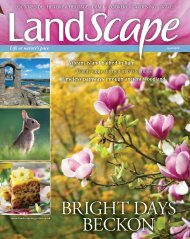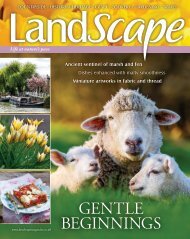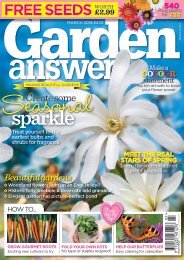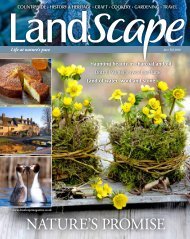Create successful ePaper yourself
Turn your PDF publications into a flip-book with our unique Google optimized e-Paper software.
Alamy<br />
Penstemons<br />
shine in pinks,<br />
mauves, blues<br />
and reds<br />
New varieties of foxgloves<br />
are often introduced at flower<br />
shows. The same is true of<br />
another member of the family,<br />
verbascums. The species<br />
themselves vary enormously,<br />
though the great majority<br />
have yellow flowers.<br />
The woolly mullein,<br />
Verbascum lanata, is a common<br />
wildflower especially prevalent<br />
on poor alkaline soil. In fact,<br />
Jonathan Buckley<br />
all verbascums enjoy such<br />
conditions and thrive best in<br />
full sun. Most are biennial,<br />
but over the past century a<br />
range of new varieties have<br />
increased the possibilities for us<br />
gardeners. The chaixii hybrids<br />
have introduced a broad range<br />
of new colours from ‘Pink<br />
Domino’ (self-explanatory)<br />
to ‘Cotswold Beauty’, whose<br />
flowers are a rich terracotta<br />
colour. Although they’re shortlived<br />
perennials, you can easily<br />
make more from root cuttings<br />
taken during the winter.<br />
There are lots of ways of<br />
using them, from growing them<br />
individually in large pots and<br />
placing them perhaps in a row<br />
along a path, to setting them<br />
among perennials and grasses<br />
in an informal planting. Biennial<br />
verbascums can be grown from<br />
seed. Sow sparingly on the<br />
surface of seed compost, cover<br />
with grit and water by standing<br />
the tray in shallow water.<br />
Last, but not least, in this<br />
delightful trio are penstemon.<br />
All the species are natives of<br />
North America, some are hardy<br />
while others are on the tender<br />
side. Nowadays numerous<br />
are available to the amateur<br />
gardener and they can be<br />
increased so easily. Simply<br />
peel off sideshoots with a<br />
short heel or take tip cuttings<br />
a few inches in length, cutting<br />
underneath a node with a<br />
sharp knife. Remove the lower<br />
leaves and nip out the tip of the<br />
cutting, then push them into<br />
gritty compost firmly as far<br />
as the first leaves. Water well<br />
and put in a bright position,<br />
though out of direct sunlight.<br />
There are surely penstemon<br />
to suit everyone’s taste from<br />
the red, flared bells of ’Firebird’<br />
to the soft and mystical, blue<br />
P. heterophyllus ‘Blue Gem’.<br />
My gardening Diary<br />
MONDAY Plants are growing<br />
so rapidly they’re in need of<br />
regular feeding. For our mixed<br />
containers of ornamental<br />
plants, dahlias, tagetes,<br />
nasturtiums and agastache in<br />
our big pots it’s a balanced<br />
feed based on seaweed.<br />
Later on we’ll use a food<br />
higher in potash to help<br />
flower production.<br />
TUESDAY One of the most<br />
exotic scents in the whole garden is<br />
produced by elaeagnus ‘Quicksilver’. Despite the flowers<br />
being tiny, bees, honey bees and other pollinating insects<br />
home in on it, attracted by the fragrance.<br />
WEDNESDAY Out with the shears to cut back some of<br />
our most ebullient geraniums. Geranium oxonianum<br />
benefits from a summer haircut. Even when it’s cut down<br />
to the ground, it’ll spring back within weeks with healthy<br />
foliage and a new crop of flowers.<br />
THURSDAY Though it might seem late in the day,<br />
we’re sowing seeds of both sunflowers and sweet peas.<br />
They’re an insurance policy as we need them both for<br />
Alice’s wedding.<br />
FRIDAY We’ve already collected seed from hellebores,<br />
now it’s the turn of the aquilegias. They’re a promiscuous<br />
lot and you never know how they’ll turn out, though<br />
white and yellow varieties usually come true from seed.<br />
SATURDAY Everyone needs to muse from time to time,<br />
but sometimes the reverie is interrupted by the wiry sound<br />
of dragonflies’ wings as they circle to and fro, landing from<br />
time to time atop a bamboo cane or tall stem.<br />
SUNDAY It’s not just penstemons but<br />
several other perennials can be<br />
increased from cuttings now. Salvias<br />
add such flower power to the summer<br />
display and taking a few cuttings, far<br />
from stopping them flowering often<br />
increases flowering when tips are<br />
removed.<br />
Carol Klein<br />
Elaeagnus<br />
‘Quicksilver’<br />
Alamy<br />
What’s looking good now<br />
Honeysuckle’s sweet fragrance<br />
Midsummer’s day has just been and gone, the<br />
most magical time of the year. Shakespeare<br />
used this time in which to set his famous play<br />
where Titania, queen of the fairies, falls asleep<br />
in a shady arbour on a bank ‘quite over-canopied<br />
with luscious woodbine’.<br />
We would recognise this woodbine<br />
immediately as honeysuckle, Lonicera<br />
periclymenum, one of the best-scented of all<br />
evening flowers. Honeysuckle has no tendrils<br />
and, unlike ivy, no adventitious roots either.<br />
It relies on twining its stems through the<br />
twigs and branches of its host. Although it’s<br />
essentially a woodlander, given any structure,<br />
tree, bank, fence or wall, it just wants to grow.<br />
With its feet in the shade and its head in the<br />
sun, it’s in its element.<br />
What do you think it smells of ? Nutmeg<br />
perhaps or cloves and a sweetness that<br />
makes you want to bury your nose into it.<br />
The super scent<br />
of honeysuckle<br />
is ravishing<br />
in the evening<br />
Subscribe for just £1 an issue. Go to www.greatmagazines.co.uk/gn<br />
<strong>July</strong> 1 2017 / <strong>Garden</strong> <strong>News</strong> 31<br />
Alamy

















